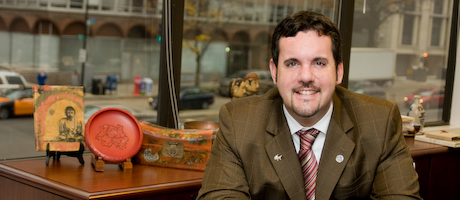Louis Lemieux took over the reins of GW’s human resources operation on Nov. 2, and it’s been a busy three weeks. He’s been working up to 14 hours a day, meeting with senior staff, deans and “anyone he can” to get input on how to improve the University’s human resources function. It’s part of his drive to make GW one of the top employers—not just in the metro region but nationwide.
To achieve that goal, Mr. Lemieux is drawing on his experience leading human resources at Columbia University Medical Center and in executive positions at companies around the globe. “I believe GW can be one of the best places to work,” says Mr. Lemieux. “We have all the raw ingredients and already offer many programs and benefits that people may be unaware of.”
Q: What attracted you to GW?
A: I was very impressed with GW’s leadership—they are inspiring people to spend time with. There is a commitment not just to deliver on the academic mission but to do something extraordinary through innovation, sustainability and service. There is a tremendous amount of collaboration, and we’re all moving in the same direction.
Q: What are your top priorities?
A: My ultimate goal is to create a world-class human resources department. We want to begin with two components: first, putting in place top-tier human resources generalists who are assigned to specific clients, such as a division or school, and really understand the needs of these clients. The second area of focus is developing “centers of expertise” with resources who have a deep knowledge base in specific areas of human resources, such as compensation, recruiting, and learning and development.
Other immediate needs include developing a more visible presence on campus and communicating more effectively with employees. We don’t want employees having to guess where to go to have their human resources needs met. One solution is a new Faculty and Staff Service Center that provides a “one-stop shop” for visitors and callers to get answers to a variety of human resources services. Other options include more online tools, just-in-time performance support for managers, and improved training and development offerings. We also have numerous opportunities to look at the functions and programs that overlap between students, faculty and staff and seek ways to not only reduce the duplication of effort but offer more services as a result of creating efficiencies.
Q: What are some of the challenges of reshaping GW’s human resources operation?
A: One of the biggest challenges for GW is space. It’s truly the final frontier and what can bind our hands in terms of expanding research efforts, attracting the highest caliber faculty, offering more space for student activities, and pursuing our other institutional goals. Ways to create space include job sharing and exploring options like “virtual officing,” the possibility of establishing smaller satellites offices in suburban Washington, D.C., locations and by moving additional functions—which are not necessary to have here at Foggy Bottom—to our Ashburn, Virginia location.
Q: Tell me about your background and where you’re from.
A: I was born in Germany and my parents were both employees of the State Department. I grew up around the world, not in cosmopolitan capitals like London and Paris but primarily in smaller, often remote African and Asian nations.
In between university and graduate school I worked in the Middle East and quickly returned to international work with a consulting firm after receiving my MBA. In the subsequent years I was fortunate to live and work for various U.S. multinational corporations in Asia, the Middle East, Africa and Europe before returning to the United States for several HR leadership positions in Boston and New York.
In the early 2000s, I took the HR, organizational development and change management experience that I had gained and started my own consulting firm. My exposure to corporate, grass-roots start-ups, as well as government, nonprofit and academic institutions enable me to bring enterprise-wide solutions and a broad perspective to my work in HR.
Q: How have you adjusted to life in D.C.?
A: I felt instantly at home here. I actually lived in the area on and off when I was growing up. It feels incredibly international, even more so in some ways than New York.
Q: What do you like to do when you’re not working?
A: I’ve been exploring Washington’s neighborhoods. My favorite so far is Capitol Hill. It reminds me of the West Village, where I lived in New York. Its proximity to downtown and the museums is a huge plus for me. I appreciate that it’s very much like a small town within a city, people stop and talk, wave to each other, and you can feel the sense of community.


